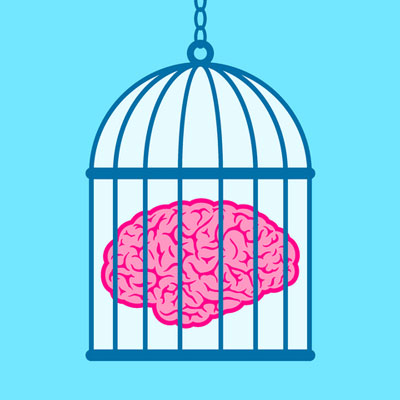
Neural plasticity, or cortical remapping, refers to the ability of the brain to form new neuronal networks throughout one’s lifetime, in response to a constant stream of new experiences. This is an idea that has only been discovered and accepted in the last 30 years or so; prior to that scientists believed that the brain’s capacity to form new neuronal pathways was fixed after a critical stage of development in infancy. What does this have to do with biotoxin illnesses (like lyme disease and mold illness) and chemical injuries that sometimes share the overlapping symptoms of environmental intolerance, chronic fatigue syndrome (CFS), and fibromyalgia (FMS)?
It appears that there is a cluster of acquired neurotoxic injuries that can be treated, at least in part, by rewiring around the damaged part of the brain. The idea is that the amygdala (our reptilian “fight or flight” center) and other areas of the limbic system have been damaged by a neurotoxic insult in a way that keeps our brains in a continuous emergency state, on high alert. In this heightened anxiety loop, our brain tamps down our regulatory body systems – including our detoxification pathways and immune responses – so that it can focus on the perceived emergency at hand, ironically making us more vulnerable to chemicals, bacteria, and viruses (which, for some people, might explain why many of us feel like walking toxic dump sites). Secondary symptoms and disease processes are then initiated, confounding the original brain injury. The stress and trauma of our bodies behaving so uncharacteristically, and the fragility and often disappearance of all our support systems (medical, home, family, financial) during our greatest time of need further entrenches anxiety-driven neural pathways, resulting in exacerbated symptoms and, many times, new disease labels.
Our symptom set may differ depending on the brain injury we sustain – among other factors like genetic predisposition, biochemistry, diet, and lifestyle habits – with viral insults commonly presenting as chronic fatigue syndrome, physical injuries (from car accidents, for example) resulting in fibromyalgia, emotional traumas causing post traumatic stress disorder (PTSD), and chemical assaults showing up as chemical sensitivity. Yet according to the theory, these are all essentially the same type of injury and current brain retraining programs focused on these types of health conditions utilize the same approach no matter which symptom picture is presenting.
The theory developed out of neurolinguistic programming based therapies like Phil Parker’s Lightning Process, but was developed further by Ashok Gupta (a self-recovered CFS patient) and Annie Hopper (a self-recovered MCS/ES/FMS patient). The Gupta Program Brain Retraining™ was initially focused primarily on CFS/ME and FMS but over the years the program was expanded to include MCS sufferers after hearing reports of improvement from patients. Hopper’s Dynamic Neural Retraining System™ addresses chemical sensitivities, but like Gupta’s program, has reported success with many other conditions such as chronic fatigue, fibromyalgia, lyme disease, anxiety and depression.
The brain retraining exercises are intended to help reprogram our unconscious stress response and calm the overactive amygdala. The theory surmises that once the amygdala is calmed and brought out of a continual emergency mode, those systems (detox, immune, etc.) that were suppressed will now begin to function normally again and the patient should start detoxing heavy metals, bacterial infections, and viruses more effectively.
Some DNRS™ workshop participants have reported the sudden “turning off of a switch” after several weeks, or sometimes only days, of doing the exercises. The “switch” being their sensitivity to environmental factors, including chemicals, foods, molds, EMFs, and other triggers. For others, the results are often more subtle and gradual. There are those who see no significant improvement at all. No matter how soon you do start seeing results, it is suggested to do the program exercises for an hour each day for a full 6 months in order to strengthen all the new neuronal pathways.
I first discovered this fascinating theory – that chemical sensitivity might not be about “toxicity,” but about dysfunction in the area of the brain that decides how to react to perceived threats and a resulting sensitization/spreading process – around 2009. I spent the next few years experimenting with the Gupta and Hopper brain retraining programs myself, as well as many related and supporting therapies – such as the Emotional Freedom Technique (EFT) and the Buteyko Breathing Method. I am not fully healed of my brain injury and subsequent sensitization to environmental triggers, but I have enjoyed important improvements in critical areas of my life — including being able to wear clothing, sleep on a mattress and use bedding, use a heating system, and expand my food choices. If you are challenged by a similar condition, I encourage you to join me and thousands of others, as we enjoy decreased reactivity levels and improvements to our quality of life.
While there was a lot of resistance to these programs when they were first introduced, they are now widely accepted and the DNRS program is used by some of the top functional medicine physicians and integrative health providers. Both the Gupta and DNRS programs are even showing great promise with COVID long-haulers. Here are just a handful of testimonials from some of those treating this patient population:
Dr. Neil Nathan
I have referred many (hundreds) of my most chemically sensitive patients and those who suffer from complex chronic illnesses to the DNRS program with results that range from great to fantastic. It is becoming increasingly clear to those of us who work in this field that “rebooting” the limbic system is a critical component for our patients and many cannot make progress until they pursue this avenue of treatment.
Dr. Raj Patel
As a physician specializing in treating patients with chronic Lyme Disease, Mold Illness and Mast Cell Activation Syndrome… DNRS is a powerful tool that has helped many of my patients immensely. It addresses the critical limbic component that we as physicians are only beginning to recognize. Having gone through the program myself… the effort and time involved is well worth it.
Dr. Cecilia Söderberg-Nauclér
About 10% of Covid-19 patients develop long haul symptoms, or Post-Acute Covid-19 disease (PACS). They suffer from various symptoms that can include high heart frequency, breathlessness, autonomic dysfunction with a high proportion of patients fulfilling criteria for postural orthostatic tachycardia syndrome (POTS), mental fatigue, muscle and joint pain, headache, nausea, cognitive impairment and memory problems, loss of smell and taste, sensitivity to light and sound, fluid retention and weight gain, gastrointestinal symptoms, high body temperature, hormonal disturbances, histamine intolerance and signs of mast cell activation syndrome (MCAS). Many of these symptoms may be explained by a limbic system impairment. So far, we have observed great to astonishing full recovery from severe long Covid / post-acute Covid-19 disease (PACS)/autonomic dysfunction/postural orthostatic tachycardia syndrome,(POTS), chronic inflammatory response syndrome (CIRS) and hyper-reactivity to food, mold and chemicals, in many patients undergoing DNRS training.
Chris Kresser, M.S., L.Ac
I’ve been treating patients with complex, chronic illness for over a decade. Addressing limbic system function is the missing key for many patients… I’ve witnessed dramatic improvements and even complete recoveries with DNRS. In many cases, these patients have been sick for years… I’ve become a huge believer in DNRS and often recommend it to my patients.
Dr. Mischa Grieder, N.D.
I am a naturopathic doctor treating chronic complex disease, specifically Lyme disease, mold, and hypersensitivities for over ten years. Over the last couple of years, many patients with mold and environmental sensitivities have [implemented] the Dynamic Neural Retraining System… and every single person has come back transformed, with clinical results nothing short of miraculous.
It should be noted that there have been a few anecdotal reports of increased anxiety, severe insomnia, bladder infections, exacerbation of PTSD, and other symptoms from doing some of the programs mentioned, which caused those participants to stop doing the exercises. Please listen to your body and proceed slowly and with care. As always, please check with a qualified healthcare provider familiar with your health history and specific symptoms before incorporating any new therapies into your recovery program.










0 Comments